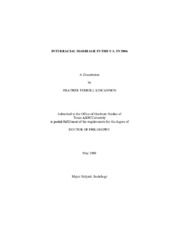| dc.description.abstract | Rates of black-white intermarriage in the United States have increased over the last sixty years, yet they remain at levels below other types of interracial/interethnic unions. Prior research has centered largely on individual-level factors associated with the formation of such unions, culminating in three not entirely consistent micro-level theories: status-caste exchange, status homogamy, and educational/economic success. Most of this literature does not consider contextual-level characteristics, which I argue should have an independent effect on the incidence of these unions. My dissertation explores these issues with microlevel and multilevel models using data from the 2006 American Community Survey. I examine both micro and macro level predictors of the odds of white women marrying black men, and black women marrying white men in the metropolitan areas of the U.S. in 2006.
In my level one analyses, six logistic regression equations are estimated to test the efficacy of the abovementioned microlevel theories of interracial marriage for black and white women. Status-caste exchange theory is accorded no support from my investigation, and status homogamy theory receives inconsistent support for white women. The results clearly convey that educational/economic success theory is applicable for predicting intermarriage among white and black metropolitan women in the United States. Among white women, those with high occupational status and high annual income are more likely to be intermarried than those with low occupational status and lower income. Among black metropolitan women, those with high occupational status and high levels of education are more likely to be intermarried than those with low occupational status and low levels of education.
In my multilevel analyses, four hierarchical generalized linear models are estimated to evaluate the likelihood of intermarriage for white and black women living in metropolitan areas in the United States. My results show that context matters in predicting and understanding intermarriage for both groups of women. Both the individual-level characteristics of the women, as well as the contextual-level characteristics of their metropolitan areas, were shown in my equations to impact their likelihood of being intermarried. Future research would benefit from the inclusion of social context in any consideration of intermarriage, particularly through the use of multilevel modeling, which until now, has not been utilized by researchers in this area. | en |


